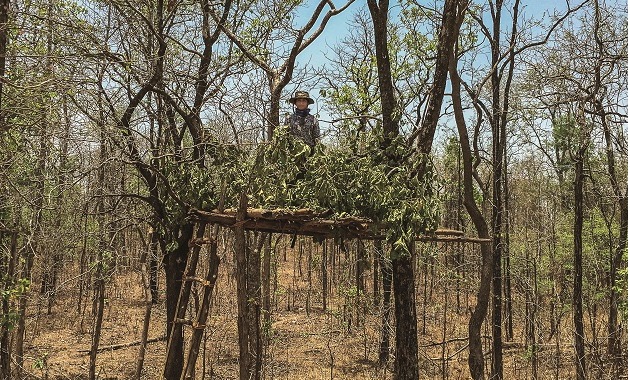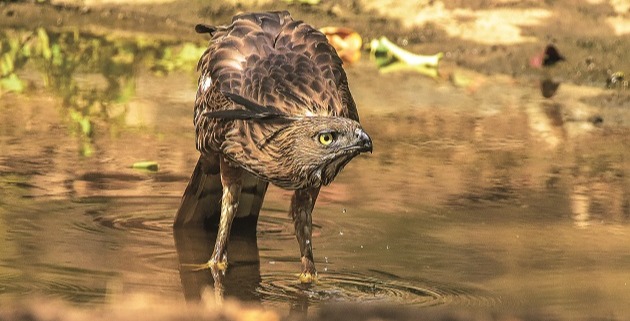A Real Forest Experience
First published in Sanctuary Asia,
Vol. 36
No. 10,
October 2016
By Sridhar Sivaram
A fortuitous glance at the Maharashtra Forest Department Facebook page led me to a post about their Annual Machaan Census. After the mandatory consultation with my wife, Priya, who was surprisingly excited about the idea, we decided to volunteer for the census. To be honest, I was a trifle apprehensive – not about the dangers of spending the night in the forest but rather the discomfort of spending almost 18 hours on a small machaan. Nevertheless, we were thrilled to be among the few selected and allotted a vantage point in Pench’s Kolitmara Range.
We reached Pench a day early, on May 20, 2016, and though it was 42oC that afternoon, we decided to explore the forest. Driving through the Kolitmara Range along the picturesque Pench river revealed a glimpse of the stunning forests in which we were lucky to find ourselves.
The next morning, we attended the Forest Department briefing on methodologies and dos and don’ts, and picked up our food packets and the log sheet on which we would record our sightings. Dehydration was a huge risk, so we carried enough water and then, together with six others, we were driven for about an hour into the jungle. Volunteers were systematically dropped off at their assigned machaans along the routes that had waterholes located close to mud tracks.
The heat was overwhelming and we knew that the going would be tough until dusk. We were finally dropped off at a small forest chowki from where we resumed our journey on a two-wheeler. Both of us, with bags, sat gingerly on a bike driven by a forest guard. It took 30 minutes of bumpy driving to reach our allotted machaan. At one point the slope was so steep that we got off and walked alongside the bike. Even before we had reached we appeared to have had enough excitement for the day!
When we reached the machaan, at about 11 a.m., days of high expectation turned out to be anti-climactic. Just three or four metres high, no roof… my wife and I exchanged wordless glances, wondering whether we had done the right thing. It was still searing hot and for the first four hours not a single wild animal showed up. Not even a bird. The first signs of life made their appearance only when it began to cool down. A rustling announced the imminent arrival of a herd of five adult bison, with two calves in tow, at the waterhole to slake their thirst. When they left the water source, a sounder of wild pigs turned up to drink and clumsily wallow. Then, the more delicate chital and sambar. By now we had forgotten every discomfort and all doubts had vanished. The satisfaction of those few minutes made the entire trip worth it. Of course, there was more in store for us. We were able to spot 25 species of birds, which we meticulously recorded, including the Indian Pitta, Orange-headed Thrush, Racket-tailed Drongo, Black-naped Monarch and the Golden Oriole.

In the heat of the afternoon, this herd of gaur arrived at the waterhole, which acted like a life-giving magnet that drew a variety of wild creatures to it. Photo Courtesy: Sridhar Sivaran
There was still light at 7 p.m, when we decided to share our packed dinner. But soon the last vestiges of the day vanished to be replaced by a blanket of darkness. Time for a change of guard. Nightjars took over from where the day birds left off. Soon the moon lent its light to the night. My wife and I were surprised at how much light the moon delivers to the forest. Just the anticipation was enough to keep us alert and engaged. Then, around 9.45 p.m. we heard a sambar alarm. Tentative at first, the calls got louder and more frequent. Undoubtedly a predator lurked nearby. In the light of the moon we could see a number of sambar in the small herd, all facing one direction. This went on for over 15 minutes, but a little later the calls died away. Who knows why, but no cat arrived on the scene.
Before our arrival we had had visions of a night of excitement, filled with secret sightings. Sitting in the silence, however, we realised that the magic of a night in the forest was different. To begin with there was not too much silence. Not as much tranquility as we had imagined. Every now and then we could hear the yelp of wild dogs, or a sambar alarm and, of course, the ubiquitous calls of nightjars. There was no question of sleep. There was no discomfort. The magic had already taken us over.

The husband and wife team were able to see wild dogs and a tiger when driving through the forest. However, from the machaan set up for the census, sightings eluded them though they heard enough evidence of their proximity by way of alarm calls. Photo Courtesy: Sridhar Sivaran
Eventually, exhaustion did set in and I don’t know when we dozed off. I woke, slightly disoriented, by a flurry of bird calls I could not identify. As the sun rose higher in the horizon, the bird activity began. We could see bee-eaters and Paradise Flycatchers hunting for insects.
For the very first time in our lives, we had spent a whole night in the forest! Stepping gingerly down from our machaan, just metres from the tree on which we sat, the forest guard pointed out the clear pugmarks of a tigress. Though we had not seen her, the sambar had alerted us to her presence. We made our way back to the forest chowki on the same bike we had arrived on. When we exchanged notes with other volunteers, we learned that they had spotted a tigress from a machaan fairly close to ours.

Perched atop the allotted machaan, the night was spent in the hope of sighting the striped cat, which was not to be. That, the author came to understand, was the reality of the forest... long periods of tranquility, broken by the occasional flurry of excitement, with luck a hunt, or perhaps a quick glimpse. Photo Courtesy: Sridhar Sivaram
We came to Pench with dreams of major tiger sightings, drama and excitement. We left much richer for our experience for we were given a chance to understand the forest as it is – throbbing with life whether we could see such life or not. We got time to sit quietly with our own thoughts and to witness a forest in which the animals were in equilibrium with their circumstances. That was the gift we took back from the forest… our place in the universe.
We did use the opportunity to drive through other parts of Pench, including Kharsapar, Sillari and Touria. Here we were fortunate to sight tigers in all three zones. My wife and I both realised that looking after a vast forest such as the Pench Tiger Reserve was neither glamourous nor adventurous. Like the denizens of the forest, its protectors too work by routine, sharing only the most exciting sightings and events, which probably gives city-dwellers the idea that when tourists leave, the forest comes dramatically alive.
What a rich experience. In our view, Pench has to be one of the most beautiful jungles in central India. If we are lucky enough to be chosen again, without a shadow of doubt, we will return to Pench for the census next year.

A Changeable Hawk Eagle cools down in the searing heat of central India. The Pench Tiger Reserve is such an excellent birding destination that the larger predators often play bit parts in the drama of life that unfolds as visitors traverse its incredibly diverse habitats. Photo Courtesy: Sridhar Sivaram





